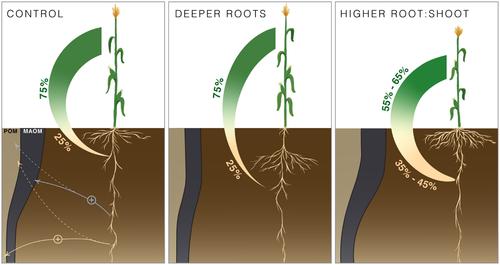当前位置:
X-MOL 学术
›
Glob. Change Biol.
›
论文详情
Our official English website, www.x-mol.net, welcomes your
feedback! (Note: you will need to create a separate account there.)
Deepening Root Inputs: Potential Soil Carbon Accrual From Breeding for Deeper Rooted Maize
Global Change Biology ( IF 10.8 ) Pub Date : 2024-11-19 , DOI: 10.1111/gcb.17591 M. Francesca Cotrufo, Michelle L. Haddix, Jack L. Mullen, Yao Zhang, John K. McKay
Global Change Biology ( IF 10.8 ) Pub Date : 2024-11-19 , DOI: 10.1111/gcb.17591 M. Francesca Cotrufo, Michelle L. Haddix, Jack L. Mullen, Yao Zhang, John K. McKay

|
Breeding annual crops for enhanced root depth and biomass is considered a promising intervention to accrue soil organic carbon (SOC) in croplands, with benefits for climate change mitigation and soil health. In annual crops, genetic technology (seed) is replaced every year as part of a farmer's fixed costs, making breeding solutions to climate change more scalable and affordable than management approaches. However, mechanistic understanding and quantitative estimates of SOC accrual potentials from crops with enhanced root phenotypes are lacking. Maize is the highest acreage and yielding crop in the US, characterized by relatively low root biomass confined to the topsoil, making it a suitable candidate for improvement that could be rapidly scaled. We ran a 2‐year field experiment to quantify the formation and composition (i.e., particulate (POM), coarse and fine mineral–associated organic matter (chaOM and MAOM, respectively) of new SOC to a depth of 90 cm from the decomposition of isotopically labeled maize roots and exudates. Additionally, we used the process‐based MEMS 2 model to simulate the SOC accrual potential of maize root ideotypes enhanced to either shift root production to deeper depths or increase root biomass allocation, assuming no change in overall productivity. In our field experiment, maize root decomposition preferentially formed POM, with doubled efficiency below 50 cm, while root exudates preferentially formed MAOM. Modeling showed that shifting root inputs to deeper layer or increasing allocation to roots resulted in a deterministic increase in SOC, ranging from 0.05 to 0.15 Mg C ha−1 per year, which are at the low end of the range of published SOC per hectare annual accrual estimates from adoption of a variety of crop management practices. Our analysis indicates that for maize, breeding for increasing root inputs as a strategy for SOC accrual has limited impact on a per‐hectare basis, although given that globally maize is produced on hundreds of millions of hectares each year, there is potential for this technology and its effect to scale. For maize–soy system that dominates US acres, changes in the overall cropping system are needed for sizable greenhouse gas reductions and SOC accrual. This study demonstrated a modeling and experimental framework to quantify and forecast SOC changes created by changing crop root inputs.
中文翻译:

深化根系投入:深根玉米育种的潜在土壤碳积累
培育一年生作物以提高根系深度和生物量被认为是在农田中积累土壤有机碳 (SOC) 的一种有前途的干预措施,有利于缓解气候变化和土壤健康。在一年生作物中,作为农民固定成本的一部分,基因技术(种子)每年都会被更换,这使得应对气候变化的育种解决方案比管理方法更具可扩展性和成本。然而,缺乏对具有增强根系表型的作物的 SOC 累积潜力的机制理解和定量估计。玉米是美国种植面积和产量最高的作物,其特点是局限于表层土壤的根系生物量相对较低,使其成为可以迅速扩大规模的改良候选作物。我们进行了一项为期 2 年的田间实验,以量化新 SOC 的形成和组成(即颗粒 (POM)、粗和细矿物相关有机物(分别为 chaOM 和 MAOM),距离同位素标记的玉米根和分泌物分解 90 cm 深。此外,我们使用基于过程的 MEMS 2 模型来模拟玉米根系表态型的 SOC 累积潜力,以将根系生产转移到更深的深度或增加根系生物量分配,假设整体生产力没有变化。在我们的田间试验中,玉米根系分解优先形成 POM,在 50 cm 以下效率提高了一倍,而根系分泌物优先形成 MAOM。建模表明,将根系投入转移到更深层或增加对根系的分配导致 SOC 的确定性增加,范围为每年 0.05 至 0.15 Mg C ha-1,处于采用各种作物管理实践的每公顷年应计估计的已公布的 SOC 范围的低端。 我们的分析表明,对于玉米来说,作为 SOC 累积策略的增加根系投入的育种对每公顷的影响有限,尽管鉴于全球每年生产数亿公顷的玉米,这项技术及其影响有可能扩大规模。对于在美国种植面积占主导地位的玉米-大豆系统,需要改变整个种植系统,以实现大规模的温室气体减排和 SOC 的累积。本研究展示了一个建模和实验框架,用于量化和预测由改变作物根系输入引起的 SOC 变化。
更新日期:2024-11-19
中文翻译:

深化根系投入:深根玉米育种的潜在土壤碳积累
培育一年生作物以提高根系深度和生物量被认为是在农田中积累土壤有机碳 (SOC) 的一种有前途的干预措施,有利于缓解气候变化和土壤健康。在一年生作物中,作为农民固定成本的一部分,基因技术(种子)每年都会被更换,这使得应对气候变化的育种解决方案比管理方法更具可扩展性和成本。然而,缺乏对具有增强根系表型的作物的 SOC 累积潜力的机制理解和定量估计。玉米是美国种植面积和产量最高的作物,其特点是局限于表层土壤的根系生物量相对较低,使其成为可以迅速扩大规模的改良候选作物。我们进行了一项为期 2 年的田间实验,以量化新 SOC 的形成和组成(即颗粒 (POM)、粗和细矿物相关有机物(分别为 chaOM 和 MAOM),距离同位素标记的玉米根和分泌物分解 90 cm 深。此外,我们使用基于过程的 MEMS 2 模型来模拟玉米根系表态型的 SOC 累积潜力,以将根系生产转移到更深的深度或增加根系生物量分配,假设整体生产力没有变化。在我们的田间试验中,玉米根系分解优先形成 POM,在 50 cm 以下效率提高了一倍,而根系分泌物优先形成 MAOM。建模表明,将根系投入转移到更深层或增加对根系的分配导致 SOC 的确定性增加,范围为每年 0.05 至 0.15 Mg C ha-1,处于采用各种作物管理实践的每公顷年应计估计的已公布的 SOC 范围的低端。 我们的分析表明,对于玉米来说,作为 SOC 累积策略的增加根系投入的育种对每公顷的影响有限,尽管鉴于全球每年生产数亿公顷的玉米,这项技术及其影响有可能扩大规模。对于在美国种植面积占主导地位的玉米-大豆系统,需要改变整个种植系统,以实现大规模的温室气体减排和 SOC 的累积。本研究展示了一个建模和实验框架,用于量化和预测由改变作物根系输入引起的 SOC 变化。






























 京公网安备 11010802027423号
京公网安备 11010802027423号